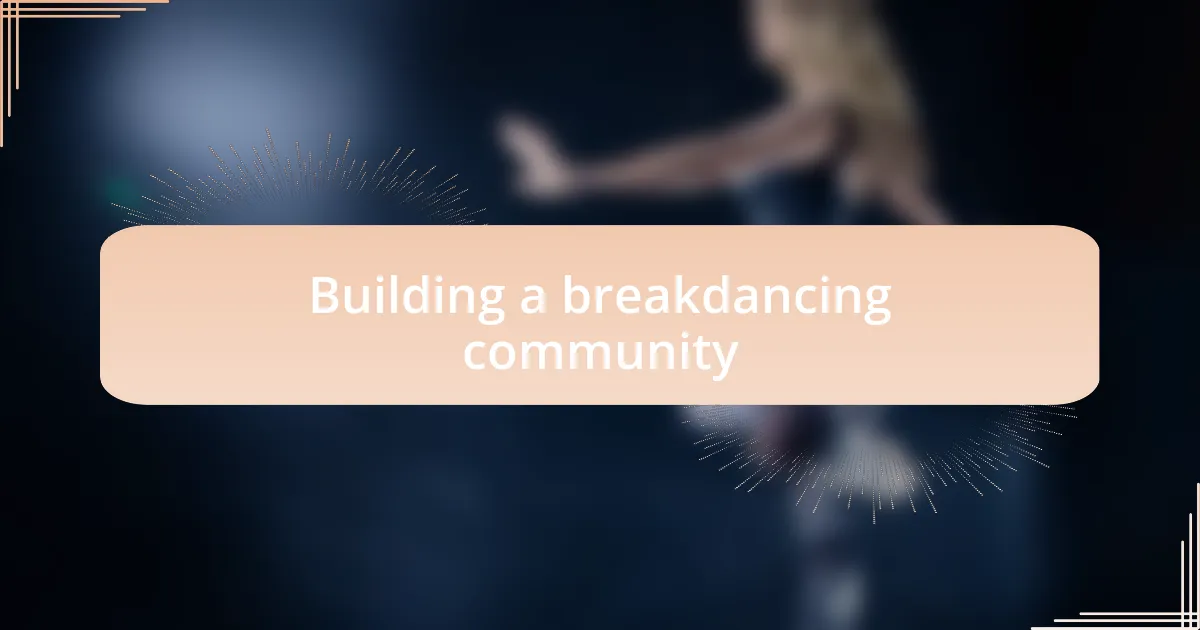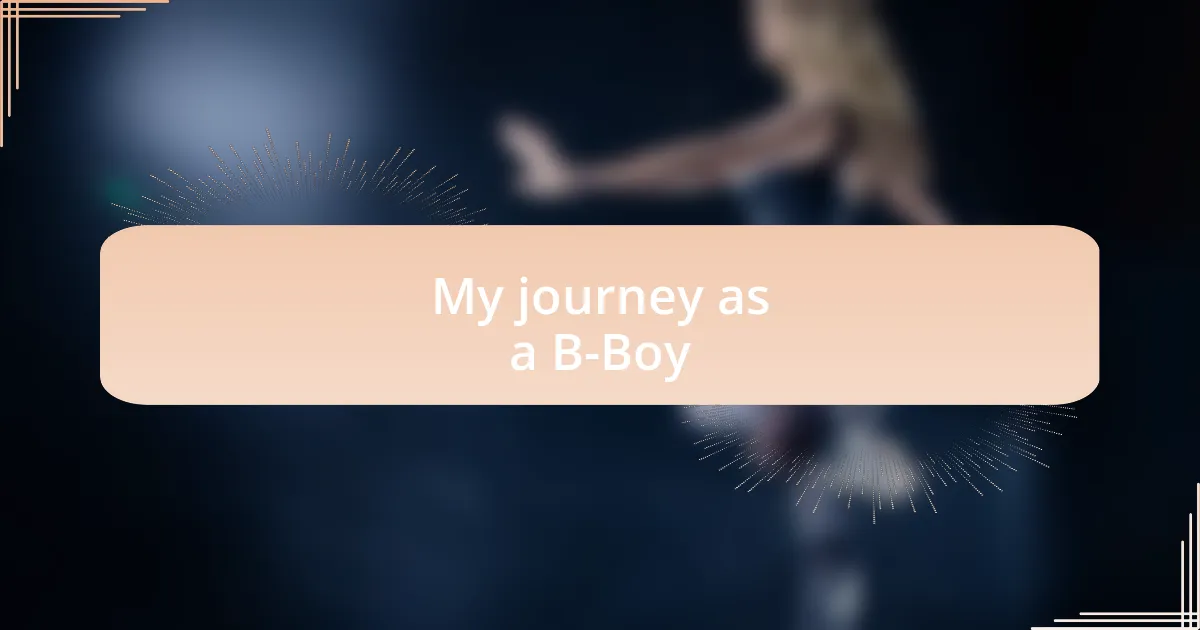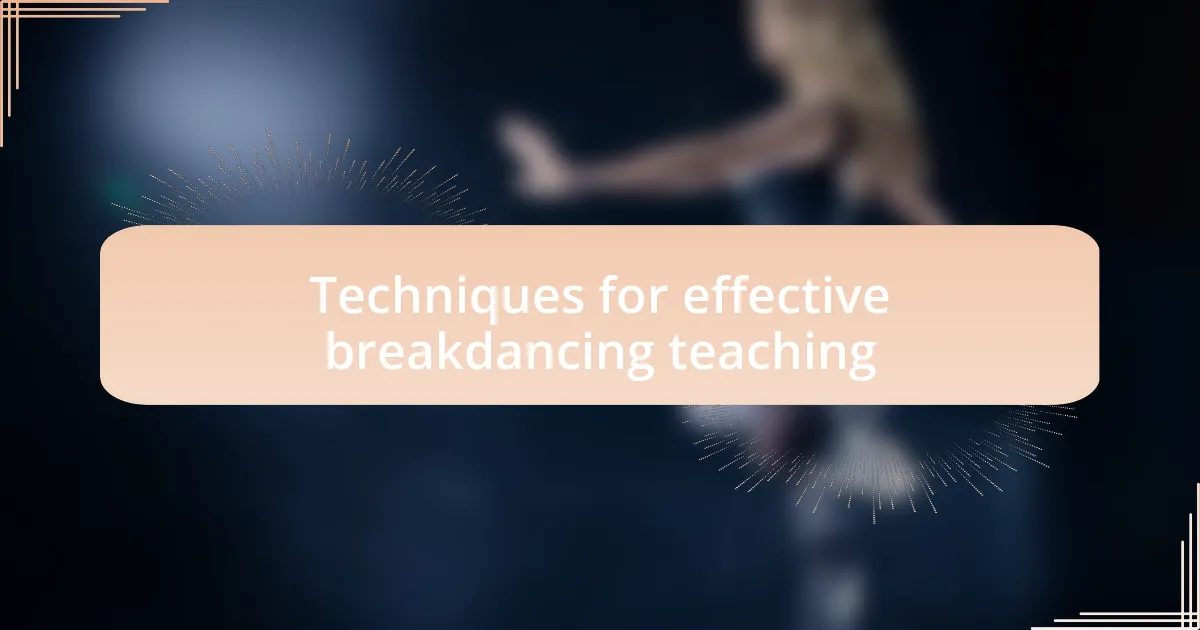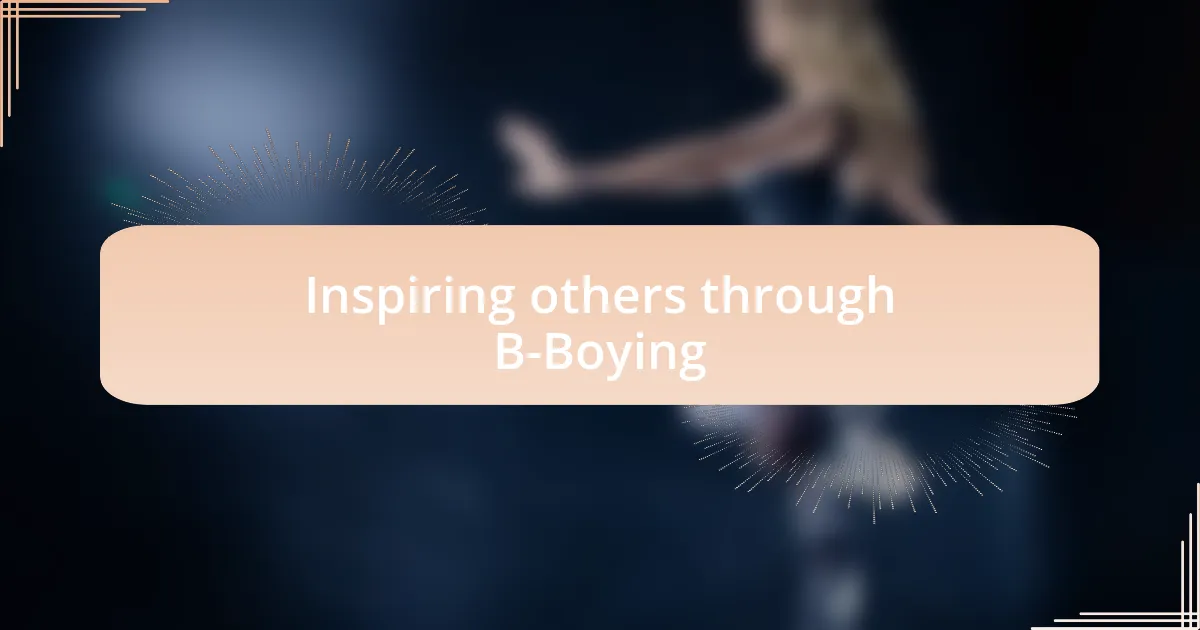Key takeaways:
- Breakdancing is centered around four core elements: toprock, downrock, power moves, and freezes, each contributing to a dancer’s unique style and expression.
- Teaching breakdancing fosters resilience, creativity, and self-expression in students, preserving the art form’s history and cultural significance.
- A strong breakdancing community thrives on relationships, mentorship, and collaboration across diverse styles, enhancing creativity and belonging.
- Inspiration from B-Boy legends and personal narratives can empower dancers to express themselves confidently and creatively through movement.

Understanding breakdancing basics
Breakdancing, or b-boying, is a vibrant dance form that combines athleticism, creativity, and style. When I first started learning the foundational moves, I was struck by how crucial the timing and rhythm are to mastering them. Have you ever felt that rush of adrenaline when you finally nail a move? It’s like unlocking a new level in a game.
At its core, breakdancing consists of four main elements: toprock, downrock, power moves, and freezes. Tops are usually where dancers start, showcasing their footwork in a standing position. I remember my first toprock routine; it felt like a conversation with the music, where every beat dictated my movement. How can it not evoke a powerful response when you feel so connected to the rhythm?
Power moves, on the other hand, showcase gravity-defying strength and control, and the first time I attempted a windmill was both exhilarating and nerve-wracking. The sensation of spinning almost made me forget my surroundings—it’s a moment that connects you with both the dance and the audience. Doesn’t that thrill resonate with anyone who has felt close to their inner passions? Understanding these basics lays the groundwork for finding your unique style and expression within the dance.

The culture of breakdancing
The culture of breakdancing is deeply rooted in community and self-expression. When I first entered the circle, I was overwhelmed by the palpable energy that comes alive in those moments. Have you ever shared a space where the air feels electric, charged by passion and creativity? That’s the essence of b-boying—the connection between dancers and spectators fuels the entire experience.
It’s fascinating how breakdancing transcends mere performance, acting as a form of social commentary and cultural identity. I remember witnessing a local battle where dancers not only showcased their skills but also told stories about their backgrounds and struggles through movement. How incredible is it that a series of spins and freezes can evoke such powerful emotions and spark conversations across different backgrounds?
Moreover, the street culture surrounding breakdancing fosters a sense of belonging. From jams in parks to competitions, each gathering caters to a shared love for rhythm and innovation. I often reflect on the countless friendships I’ve built through these events; it’s like finding a second family. Isn’t it amazing how dance can bond people together, crossing barriers and uniting us in the joy of movement?

Importance of teaching breakdancing
Teaching breakdancing is essential not just for skill development, but for passing on the values of resilience and creativity. As I guide students through their first windmills or headspins, I often see a spark of determination in their eyes. Have you ever seen someone’s face light up when they finally nail a challenging move? It’s a moment that goes beyond dance; it’s about achieving a personal victory.
In my experience, teaching this art form creates a space where young dancers not only learn choreography but also develop confidence and self-expression. I recall working with a shy teenager who initially hesitated to even step forward during sessions. Over time, as they embraced the movement, their self-esteem blossomed. Isn’t it remarkable how dance can serve as a tool for personal transformation?
Moreover, imparting knowledge about breakdancing preserves its rich history and cultural significance. Through teaching, I feel a responsibility to honor the pioneers who shaped this dance. During one of my workshops, I shared stories of legends like Kool Herc and Rock Steady Crew, hoping to inspire a new generation. Doesn’t it feel important to keep these narratives alive? Each class becomes a bridge, connecting the past with the future while fostering a sense of identity among students.

Building a breakdancing community
Creating a breakdancing community goes beyond just sharing skills; it’s about nurturing relationships and fostering a sense of belonging. I remember the first time I hosted a local jam. It was thrilling to see dancers of all levels come together, encouraging each other and exchanging tips. Isn’t it incredible how shared passion can break down barriers and create friendships that last well beyond the dance floor?
One of my favorite aspects of building our community is witnessing the collaboration between different styles. I often invite dancers from various backgrounds to showcase their unique approaches during our cyphers. For instance, when a b-girl collaborates with a popping dancer, it not only inspires creativity but also highlights the beauty of blending diverse influences. Who would have thought that a simple dance gathering could spark such innovative exchanges?
As we’ve grown, I’ve seen the importance of mentorship within the community. I often take the time to teach not just the moves, but the stories and experiences behind them. There’s something profoundly rewarding about passing on knowledge to the next wave of dancers. When a novice approaches me for guidance and I see their eagerness to learn, I can’t help but reflect on my own journey and the mentorship that shaped me. Isn’t it fulfilling to know that we can carry the torch forward together?

My journey as a B-Boy
As I embarked on my journey as a B-Boy, each twist and turn on the mat became a step toward self-discovery. I remember my first practice session – the excitement mixed with nerves as I attempted my first windmill. It was clumsy, but that feeling of movement, of pushing my body beyond its limits, ignited a passion I never knew was there. Isn’t it amazing how a simple dance move can lead to profound self-expression?
Over time, I found myself immersed in the culture of breakdancing, attending workshops and battles that felt like rites of passage. I still vividly recall a competition where I faced off against a seasoned B-Boy who had inspired me early on. The adrenaline rush was unlike anything I had experienced, and even though I didn’t win, the lessons I learned about resilience and determination were invaluable. Have you ever had a moment when losing felt like winning in disguise?
Looking back, I realize that each challenge I faced shaped not just my skills but my character. There were days when I wanted to give up, doubting whether I was good enough. But every stumble on the dance floor was a reminder that growth comes from perseverance. The camaraderie and support from fellow B-Boys during those tough moments made all the difference. Isn’t it true that sometimes, our greatest battles forge the strongest bonds?

Techniques for effective breakdancing teaching
Creating a strong foundation in technique is essential when teaching breakdancing. I often emphasize the importance of mastering basic moves like the six-step and the top rock before diving into more complex elements. It’s fascinating how repetition can transform awkward movements into fluid transitions—don’t you feel a sense of achievement when you finally nail that move you’ve practiced tirelessly?
Another effective technique is encouraging peer feedback among students. I remember hosting a session where each dancer demonstrated their latest move, followed by supportive critiques from their peers. This not only fosters a sense of community but also pushes everyone to improve through collective insights. Have you ever noticed how a fresh perspective can illuminate something you’ve been struggling with?
Incorporating storytelling into lessons connects students emotionally to the dance. When I share the history behind certain moves or the origins of breakdancing culture, I can see the spark in their eyes. Suddenly, it’s more than just dance; it’s about being part of something bigger. Isn’t it rewarding when students embrace not only the technical aspects but also the rich heritage of the art form?

Inspiring others through B-Boying
One of the most fulfilling aspects of B-Boying for me is witnessing the transformation of my students. I remember a shy young dancer who, after a few months of lessons, stepped onto the floor and surprised everyone with her confidence and creativity. It’s these moments that remind me how powerful dance can be in building self-esteem—don’t you think it’s incredible how movement can empower someone to express who they truly are?
I also strive to inspire others by sharing the journey of prominent B-Boy legends. When I tell my students about their struggles and triumphs, it breathes life into the dance. I often see their eyes light up, as they realize that even the best started somewhere. Isn’t it amazing to know that each of us is on a unique path, and that the stories of those before us can motivate fresh talent to push boundaries?
Additionally, I encourage my students to find their own voice in B-Boying. I remember when one of my students created a unique move inspired by his personal experiences. Watching him own it was a revelation; it wasn’t just about mastering the steps, but about telling his story through dance. Have you ever considered how sharing your own narrative can inspire others to find their creative expression?